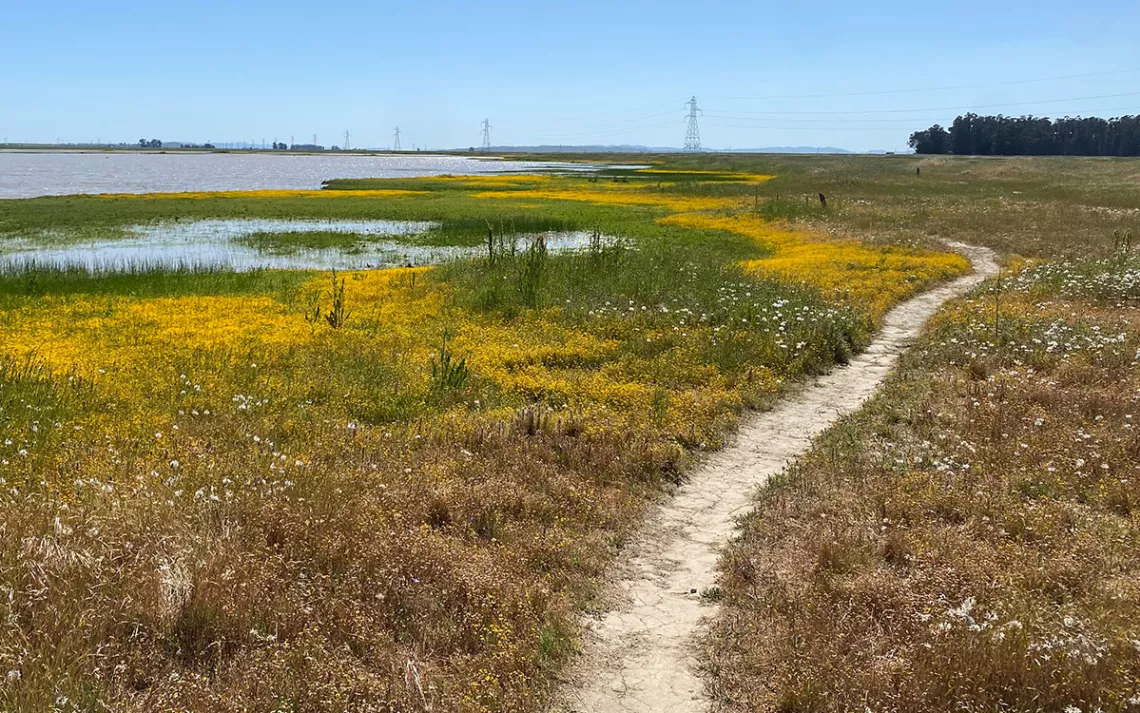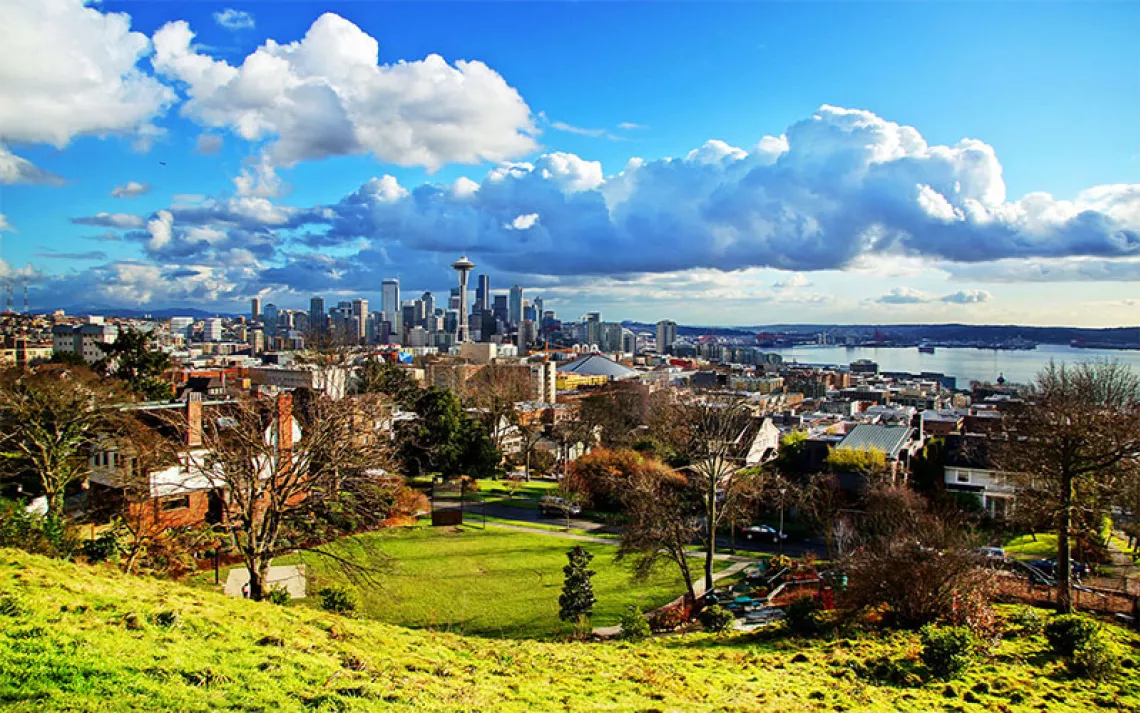A Billionaire-Backed City Promises to Be a Green Urban Paradise
But it may not be what it appears

Jepson Prairie Reserve, adjacent to Flannery Associates' proposed development, hosts one of the few remaining vernal pool habitats and native bunchgrass prairies in California.
Editor's Note: On July 22, 2024 county leaders and backers of the California Forever project agreed to pull the initiative off the November ballot and proceed with the usual review process including a full Environmental Impact Report.
A plan to develop a new city northeast of San Francisco has been seven years in the making, but until recently, the details were largely kept under wraps. Now that the plans are public—and the proposal has garnered enough signatures to make it onto the November ballot for voter consideration—residents and activists are squaring off to defeat what the developers promise will be a kind of green urban paradise.
Not so, say many of the plan’s opponents. “My fight has all of a sudden started to heat up,” said Joe Feller, chair emeritus of the Solano Group of the Sierra Club’s Redwood Chapter, on the day the proposal made it onto the ballot.
For years, a mysterious LLC known as “Flannery Associates” was quietly buying up vast swaths of Solano County farmland. No one knew who they were or what they were doing. These large real estate plays, it now turns out, were part of a project backed by a who’s who of Silicon Valley billionaires—among them Reid Hoffman, the cofounder of LinkedIn, and Laurene Powell Jobs, the founder of Emerson Collective and widow of Steve Jobs—to build a new city that would house up to 400,000 people. Renderings of the city depict an eco-oasis with dense middle-class housing, solar-powered homes, walkable neighborhoods, open green space, and access to public transportation. The project, the developers claim, will solve the Bay Area’s housing crisis.
But according to Feller and several environmental groups who have banded together to oppose the project, it is not what it seems. Despite its promises, the development would come at a major cost to Solano County’s natural environment. And there has been little community engagement about the proposed project or its potential impacts.
On a Sunday afternoon last February, as rainfall flooded roads across Northern California, hundreds of Solano County residents gathered at a community center in Suisun City to celebrate the launch of Solano Together—a coalition of concerned residents and organizations opposed to Flannery Associates' plan. The crowd that day included a wide range of community members with varying political views. At the event, impassioned farmers, environmentalists, and local leaders expressed outrage at how Flannery Associates had left them in the dark about their plan, which, they say, was a ploy by the developers to ensure low prices and minimal community resistance. The crowd was fired up, erupting in cheers between each speaker. Unlike the land—of which Flannery now owns nearly 10 percent—“the spirit here is not for sale,” said Princess Washington, mayor pro tem of Suisun City and the chair of the Redwood Chapter’s Solano Group.
In April, months after the launch of Solano Together, Duane Kromm and Marilyn Farley, a retired couple who have been helping lead the coalition, drove a reporter north along Highway 113 to visit the site for the proposed city. Vast fields of hay and barley extended far into the distance. Clusters of sheep and cattle dotted the landscape. Trees were few and far between. “This would all be four, five, six stories tall,” said Kromm, who is a member of the Solano Orderly Growth Committee.
Before Flannery Associates can begin development, a host of barriers stand in its way—the foremost being Solano’s land-use restrictions. At the heart of the county’s development philosophy is “what is urban should be municipal,” Kromm explained. Concurrently, land zoned agricultural cannot be developed, which is what has kept large swaths of the region rural for so long. According to Solano County’s Orderly Growth Initiative, any zoning changes must be voted on, which is why Flannery is seeking voter approval this November.
Though Flannery claims on its website that the farmland poised for development is “non-prime,” only contributing approximately 1.6 percent of Solano County’s total agricultural revenue, Farley believes that Flannery’s plan threatens more than the local economy. This development, she said, would strike at the core of Solano's identity. “They've disrupted a whole farming system. And they've disrupted families, many of whom have been on that land since the late 1800s,” Farley said. The loss of US farmland is rampant, she noted, with 2,000 acres of farmland lost to development every day, which threatens local food supplies in addition to the biodiversity that land supports.
Under the stewardship of its former owners, the farmland, now owned by Flannery, has been carefully managed. The farmers practice dryland farming, Farley explained, a practice of growing crops without irrigation, done to save water. Typically, farms will have a year growing grain, a year of fallow, and a year of grazing, she said. “It’s very sustainable.”
These grasslands are also “biodiverse ecosystems that are underrepresented in protected areas statewide,” said Nate Huntington, a resilience associate at Greenbelt Alliance, one of the environmental groups that opposes the project. “When they're well managed, grazing areas can host important biological resources and mitigate climate change through carbon sequestration.” Though the carbon stores on this land have yet to be calculated, intuitively, Kromm said, if you pave it all over, “that’s not going to be good.” Data for the biological resources located on the land is still limited since the developers have yet to conduct an environmental impact statement, which likely won’t take place until after the November elections.
Adjacent to Flannery’s land lies Jepson Prairie, one of the few remaining vernal pool habitats and native bunchgrass prairies in California, owned and managed by the Solano Land Trust. Yellow California goldfields were at peak bloom, drawing yellow stripes around the pool. Farley, who was careful to stay on the narrow trail that winds the reserve to avoid disrupting the habitat, fears what the land would look like if it were to become the backyard of 400,000 new residents. “There’d be a lot of people here,” she said. “Who knows what they’ll do.” The reserve provides habitat for a host of threatened and endangered native wildlife, including burrowing owls, monarch butterflies, California tiger salamanders, and 15 rare and endangered plant species.
The preserve is only a small part of the Jepson Prairie ecosystem, said Carol Witham, a vernal pool specialist. Little by little, that protected area has been expanding. But now, that door has closed. “Flannery has come out and bought a whole bunch of parcels that make it impossible to continue to do that,” she said. In the area surrounding the prairie, Flannery Associates now owns 60 percent of the county's unprotected freshwater marshes, 50 percent of the high-value vernal pool conservation land, and 34 percent of the region's priority areas for conservation, which conservationists fear is at risk of destruction.

Sign up to receive Sierra News & Views
Get articles like this one sent directly to your inbox weekly.
With this action you affirm you want to receive Sierra Club communications and may vote on policy designated by the Sierra Club Board.
The San Francisco Bay Area has suffered from one of the worst housing crises in the nation and one that local leaders have largely failed to address. For decades, rising prices have been pushing middle- and low-income residents out of urban centers like San Francisco. Housing experts agree that low-income and middle-class housing must be scaled up to meet the community’s needs, which Flannery’s plan—in theory—would provide.
In response to questions from a reporter, Flannery Associates said that it seeks to negate the harmful impacts of urban sprawl by building a city that is much denser than a typical American suburb. “We have proposed a community where people can live, work, and take care of most of their needs within walkable neighborhoods,” a spokesman said in an email.
The developers claim that building a city from the ground up allows them to incorporate the newest, most efficient technologies. In addition to generating enough renewable energy from wind and solar to power 1.5 million homes—far surpassing the needs of the immediate community—they plan to deploy “ultra-efficient” water recycling and thermal energy systems. “Overall, we are confident that our project will provide one of the best models in the world for drastically reducing per capita greenhouse gas emissions,” the project claims. Developers also promise to create 15,000 local jobs.
“But there are some impacts that are going to be very, very difficult to mitigate. First and foremost is the need for transportation,” said Daniel Rodríguez, professor of city and regional planning and director of the Institute for Transportation at the University of California, Berkeley. He has studied similar “new urbanist” developments that, in their early stages, shared many of Flannery’s aspirations. “Over and over, we found that the transportation claims that the developers made rarely materialized. Residents of these communities traveled as much as residents of any traditional suburb.” Despite Flannery’s plans to create an “employment cluster” in Solano County, the reality is that “jobs don't cluster because developers would like them to,” Rodríguez said. Flannery’s conception sounds like “magical thinking,” he said. Inevitably, residents will wind up commuting to already existing urban centers.
While the developers advocate for building a transit system to support a more energy-efficient alternative for commuters, existing public transportation in many California cities is nearing collapse and in need of major investment, said Rodríguez. It would be “fiscally irresponsible to even think about investing in a rail system for a city that hasn't been built,” he said.
While alternative options may require “a little more tinkering,” as Rodríguez put it, better alternatives are possible—and some are already underway. In the East Bay, the Concord Reuse Project, which will be developed on the site of a former naval weapons station, is slated to deliver over 12,000 homes, a quarter of which will be affordable and located adjacent to an existing transit station. In contrast to the project in Solano County, the Reuse Project has been developed across a diverse coalition of labor, environmental, and faith-based organizations. “It’s a climate-friendly and equitable development that is connected to existing communities,” said Sam Tepperman-Gelfant, managing attorney at Public Advocates.
Despite the well-funded campaigns behind Flannery’s plan, Kromm doesn’t feel threatened by their chances. A recent poll showed that 70 percent of Solano residents oppose the project. But activists expect Flannery’s fight won’t stop there.
What ultimately happens in Solano County “will set a precedent for what's going to happen in the future with people who have the means to privately purchase land and develop open space,” Washington said. “This is not an isolated incident. It will continue to happen, and we are on the front line of this decision.”
 The Magazine of The Sierra Club
The Magazine of The Sierra Club



